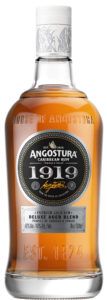Angostura: Bitter Truth
If you’ve ever frequented a bar, nightclub or restaurant, you’re well aware of the distinctive bottle. Small in stature, jacketed with an oversized label and topped with a yellow cap, Angostura’s iconic aromatic bitters are a staple in bars across the globe, and, flanked alongside a selection of smooth rum blends like the 1919 and 1824, are key components in the cabinet of Trinidad’s House of Angostura.
Angostura’s story begins with a German in Venezuela. Johann Gottlieb Benjamin Siegert had served at the battle of Waterloo as a military physician, patching up wounded British and Prussian soldiers in the wake of Napoleon’s attempt to conquer Europe. In 1820, Siegert relocated to Angostura, Venezuela (now Ciudad Bolivar) to assist Simon Bolivar’s campaign to free Venezuela from Spanish colonial rule. Impressed by Siegert’s aptitude and experience, Bolivar promoted Johann Siegert to Surgeon General. In 1824, Siegert developed a medicinal tincture called “Amargo Aramatico” (Aromatic Bitters) with the intention of remedying the stomach ailments, seasickness and malaria of Bolivar’s troops.
Siegert realised he was onto something. Rather than join Bolivar’s movement into Ecuador, Peru and Colombia, Siegert decided to stay in Venezuela and further develop the elixir he had made. His interest in chemistry and botany coupled with the unique plant life the New World had to offer led to the perfection of the bitters formula, which he called “Dr. Siegert’s Aromatic Bitters”. While the palliative effects of the bitters can be argued, popularity quickly took off and the bitters became a mainstay on ships that passed through the port of Angostura – a catalyst for the bitter’s reputation going global. A distillery was established in 1850 and exports to England and Trinidad commenced the same year.
If Johann Siegert was the scientific genius behind the bitters, then it was his son Carlos, that took the bitters to new heights. During this period aromatic bitters began making the transition from being a medicinal product to a cocktail additive. Don Carlos took the bitters to London in 1862, combined the bitters with gin, inventing the “Pink Gin” cocktail in the process. Visits to Vienna in 1873, Paris and Philadelphia in 1867 and Australia in 1873, soon followed and cemented the now-renamed “Angostura Bitters” as a sought after brand. Bitters took the world by storm, helping birth cocktails such as the Manhattan, the Champagne cocktail and the Old Fashioned. Angostura Bitters even found a fan in Mark Twain, who penned an 1874 letter to his wife asking for the bitters to be stocked in the bathroom upon his return from London.

Johann Siegert passed away in 1870, and it was during this time that Venezuela faced political and civil unrest. Antonio Guzman Blanco took dictatorial control over Venezuela, leading to a diaspora of thousands of Venezuelans, many of whom took a new home in Trinidad. Recognising this, Siegert’s business, now fronted by his sons Carlos, Alfredo and Luis relocated to Port of Spain, Trinidad in 1875, where the company continues to thrive. The quality of Angostura’s bitters earned the brand a Royal Warrants of Appointment – a distinction given to brands that have a direct right to supply the British Royal family their goods and services.
The bottle’s unique, oversized label has a rather serendipitous origin. The Siegert brothers during the brand’s early years entered the bitters into different competitions. Prior to a competition, one of the Siegert brothers was assigned the task of designing the bottle and another brother entrusted to design the label. Unfortunately (or fortunately depending on your outlook), neither brother had consulted with one another about sizing, resulting in the mismatch. By the time the mistake had been realised it was too late, and the bitters bottle was entered into the competition with its unusual label sizing. Even though the bitters lost the competition, one of the judges recommended the bitters stick with its “signature” labelling, and thus formed the label that still adorns Angostura Bitters bottles to this day.
So what’s in the bottle? Well, it’s a trade secret. It’s believed that Angostura’s concoction is composed of over 40 ingredients, and only five people know the exact formula. What we do know however, is that the secret ingredients are sourced from England, where they are carefully bagged separately. The ingredients are then sent off to Trinidad, passing through customs without inspection to retain their secret, thanks to a long-standing agreement the Siegert family has with Trinidadian customs.
The ingredients then end up in a room known as “the Sanctuary”, where they’re then crushed and dropped into carts below in a “Bitters Room”. The crushed base mixture is then added to giant “percolator” tanks, infusing with 97% alcohol to extract flavour. Brown sugar and caramel colouring is finally added to the mix, with distilled water bringing the alcohol level to 44.7% – ready for bottling.
Aside from the iconic bitters, Angostura’s rums are worthy additions to any spirit aficionado’s top-shelf. Rum became part of the Angostura House in 1973 when it purchased the Fernandes Family Distillery, which has distilling history tracing back to the 1890s. Angostura’s 1919 and 1824 rums in particular, are rums exemplary of excellence.

Angostura 1919
The 1919 is named after a precise date of significance in Trinidad & Tobago’s rum industry. A 1932 fire destroyed the Government Rum Bond but charred casks from the year 1919 were found intact. The casks were purchased and blended into what was known as “1919 Aged Rum”. The rum was so highly regarded that Angostura continues to let the legacy of 1919 live on with this range.
The 1919 is an award winning specially blended rum and for good reason. Made from a blend of light and heavy molasses, the 1919 shines with a golden, amber-like hue. On the nose it leaps forth with a bouquet of caramel, vanilla and cocoa. Incredibly smooth and with a silky mouthfeel, the 1919 breezes over the palette without any harshness, leaving a warm creamy finish.

Angostura 1824
The 1824 in the name refers to the year that Siegert first produced the famed aromatic bitters, and with a date so important to Angostura, the 1824 more than holds up to the bar set.
Sporting a copper, almost dark mahogany hue in comparison to the 1919, the 1824 is a medium-bodied rum that spends a minimum of 12 years in American oak bourbon barrels before it is blended and re-casked. Notes of toffee, cocoa and orange peel spring forth to the nose, while oak, chocolate and butterscotch characters take precedence on the palette. With a smooth finish that leaves hints of cinnamon and orange, the 1824 is a prime example of what a world class rum should be.

